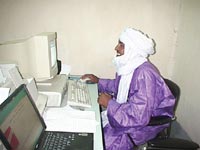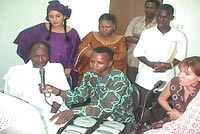MCT pilot projects
The story we are about to tell you is a
true one: it was heard of and took place in Timbuktu. It is the story of
a young Moorish blacksmith from “the mysterious city” who told a visitor
from his remote village, “I will send you a message by e-mail”. And indeed,
he can now do so, thanks to Timbuktu’s multipurpose community telecentre (MCT)
— a pilot project launched in 1997. Timbuktu, which is the “gateway to the
desert” and considered the “end of the world”, has quite simply become a
part of that world.
Timbuktu’s MCT belongs to the community, which was deeply
involved in its establishment. As its name indicates, the MCT offers a multitude
of services: Internet, e-mail, software installation, scanner, word processing,
colour printing, Web page hosting, telephone/fax, photocopying, maintenance and
repairs (see chart).
|

ITU 020069/Birama Diallo, SOTELMA

ITU 020068/Birama Diallo, SOTELMA
|
The telecentre’s sustainability will depend on its financial and
institutional capacity to remain operational long after assistance, so
that the “young Moorish blacksmith” can continue not only to send
e-mail messages but also to surf the Internet from “the end of the world”
and participate fully in the telecentre’s management
Photos: A trader surfing the Internet to know what price
he will get for his livestock
MCT end-users receiving training
|
The Internet is the main product. An invaluable tool for
information searching, trade and communication, the Internet has brought the
whole world into a network and has become commonplace in Timbuktu, where the
young Moorish blacksmith readily compares it to one of the traditional tools of
his trade. “It is just a working and communication tool that looks
sophisticated but is easy to use”, he says.
The MCT connects the town of Timbuktu, which is sandwiched
between the Issa Ber River and the sand dunes of the desert, with the rest of
the world. Timbuktu’s inhabitants now have access to all the services
available on the Net (electronic messaging, file transfer, database
consultation, etc.). What the inhabitants ultimately expect is that the MCT will
promote the local development of, among other things, tourism and crafts,
agriculture, livestock-breeding and fishing, industry, teaching, culture and
medicine (telemedicine).
The main areas covered by the MCT evaluation relate to the
centre’s sustainability and its capacity to provide social and economic
benefits to the community in the best possible conditions.
Since its launch, the MCT has gone through a number of
phases, acquiring experience and encountering obstacles along the way.
Multipurpose telecentres are a new form of community institution in Africa in
general, and in Mali in particular. Urban and rural communities alike have
pinned their hopes on them. Those involved — the project implementing team,
the operators, the people and businesses that will benefit — are all firm
believers in the telecentre and anticipate that in the short and long term it
will have a positive impact on their lives and means of survival.
Excerpt adapted from the foreword to the final report on
the evaluation of the multipurpose community telecentre in Timbuktu, carried
out by the International Development Research Centre.
|

ITU 020071

ITU 020072
Children broadcasting for children
Photos: Birama Diallo, SOTELMA
|
International partners in the Timbuktu project are ITU, IDRC,
UNESCO, FAO and WHO. National partners include Societé des
Télécommunications du Mali (SOTELMA), the country’s telecommunications
operator, the national commission for UNESCO and the Ministry of Culture and
Tourism. The local community raised USD 30 000 as a contribution for the
construction of the MCT building, which was inaugurated in June 2001. ITU
procured information technology equipment for the MCT. This has been installed
and is functioning satisfactorily. Mali’s former President, Alpha Oumar
Konaré, visited the MCT at the end of March 2002.
A baseline study conducted in May 1999 by the PACT Institute,
an NGO based in Washington, DC, examined the information uses and needs of
Timbuktu using a mixture of household surveys, user questionnaires, focus groups
and interviews. Several libraries in Timbuktu will benefit from the new services
of the telecentre.
Key beneficiaries include the famous Centre Ahmed Baba
Library with its precious collection of books and documentation,
regularly visited by national and international researchers, as well as
tourists; and the library of the Mahamane Alassane Haidara Lyceum,
visited daily by about 300 students. Similarly, the various lyceums and medersas
and the new Lycée Technique Agricole at Niafunke stand to gain from
support provided through the MCT in basic and advanced computer-literacy
training, maintaining and updating educational curricula in electronic format,
teacher training, Internet-based communications and access to information for
both teachers and students.
 Another major emphasis of the telecentre is to provide
training to artisans to set up websites in order to sell their handicrafts. The
telecentre has proved to be particularly useful to tour operators organizing
visits to a place as rich in culture as Timbuktu. There are plans to digitize
the collection in the local museum and the manuscripts in the Centre Ahmed Baba
Library. Another major emphasis of the telecentre is to provide
training to artisans to set up websites in order to sell their handicrafts. The
telecentre has proved to be particularly useful to tour operators organizing
visits to a place as rich in culture as Timbuktu. There are plans to digitize
the collection in the local museum and the manuscripts in the Centre Ahmed Baba
Library.
|


ITU 020070
Photos: Birama Diallo, SOTELMA
|
The telecentre also operates a small radio broadcasting
station and produces its own programmes.
Run by technical staff, the telecentre is overseen by a
steering committee, which includes the mayor, business people, artisans,
librarians, health workers, women’s associations and other members of the
community. Prices for services are set by the steering committee. There are also
special discounts for women and children.
FAO plans to use the telecentre as a local base for its
development work. This project will link to the Rural Community Radio and the
FAO World Agricultural Information Centre.
Both SOTELMA and ITU/BDT have agreed to extend the project
through September 2002. The DOMSAT link between Timbuktu and Bamako will be
upgraded to handle a leased 64 kbit/s line to the MCT. This should result in
better quality of services and a more sustainable project.
A major objective is to transfer the project to community
ownership at the end of the pilot phase.
|